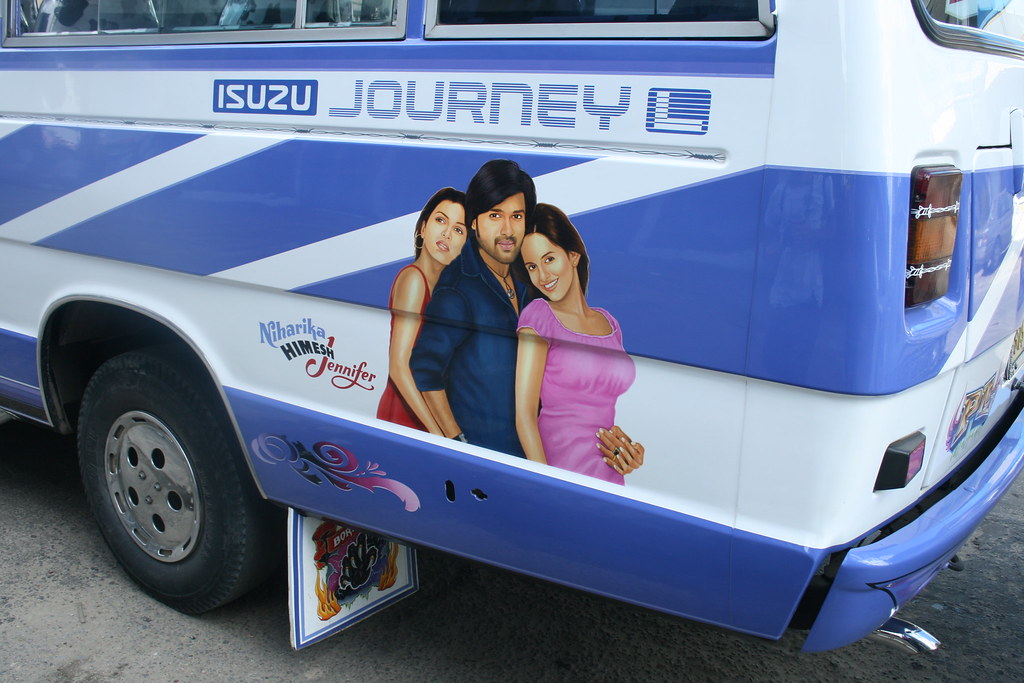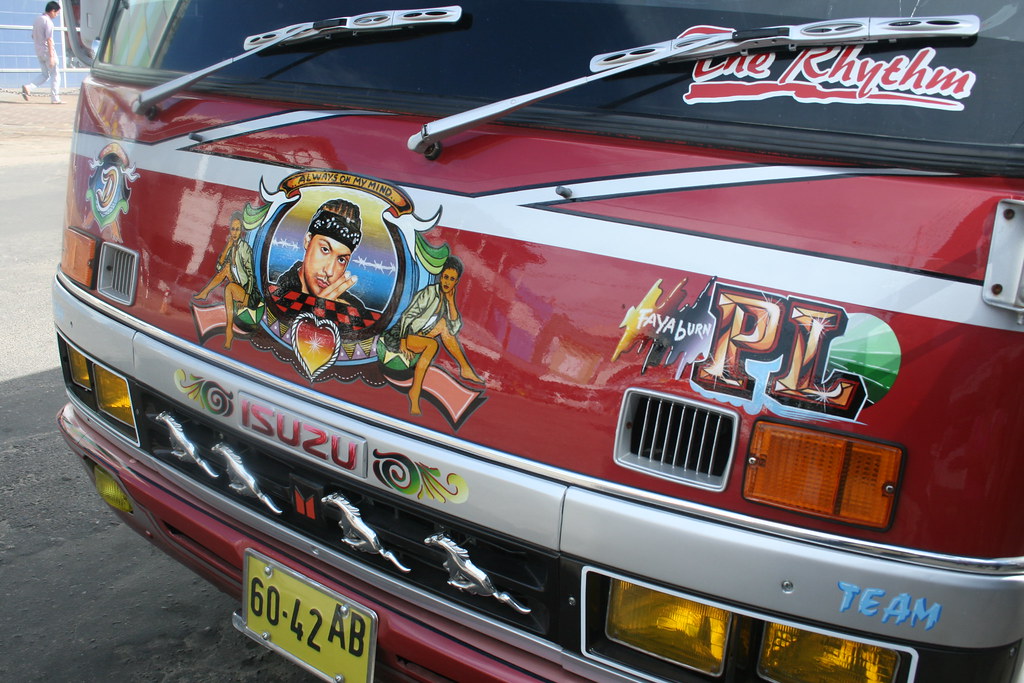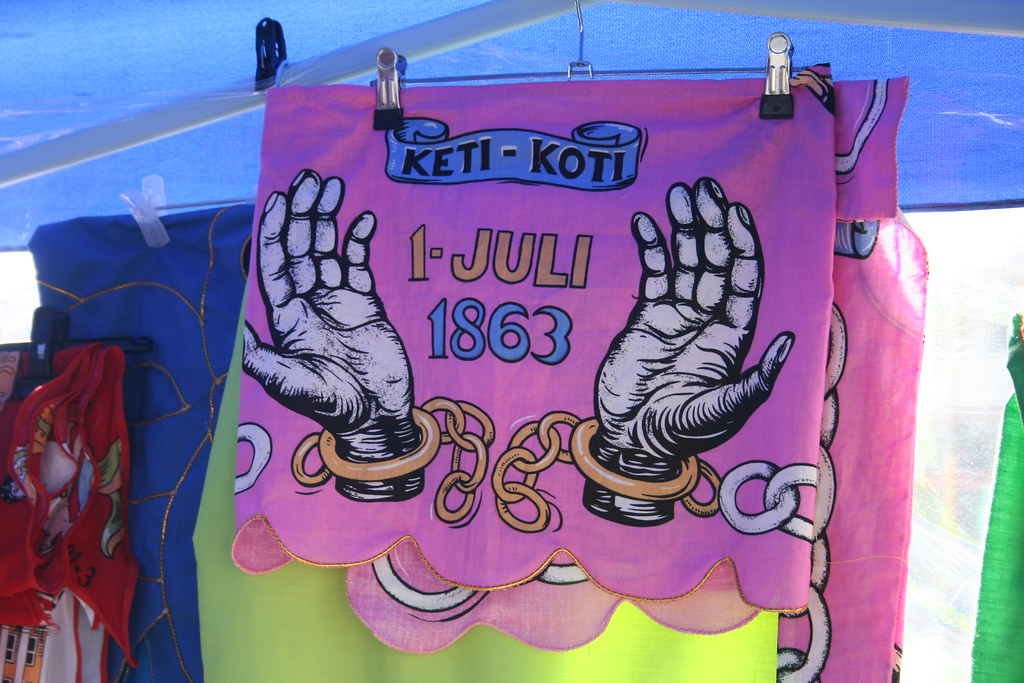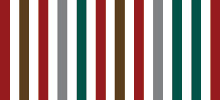By Christopher Cozier
Painting of Bollywood stars on a minibus in downtown Paramaribo, June 2009. Photo by Christopher Cozier
Initially, I was thinking of a theme around bridges, derived from the obvious: the two distinctive bridges, the Jules Wijdenbosch Bridge in Paramaribo and the Erasmus Bridge in Rotterdam. Both registered on my mind from the landscape on my first visits. For both cities, the bridges are significant to their stories and ambitions, reaching across not just water but communities and ways of understanding or experiencing where they are located. To me, this spoke about the role of visual practice and its dialogues--its potential to make connections between artists working in different but related circumstances.
In discussion with Marcel Pinas, Chandra van Binnendijk, Marieke Visser, Thomas Meijer, and Nicholas Laughlin, in what’s left of the iconic bar at the Torarica Hotel, the word “span” came up. Nicholas wanted to know whether, in local languages or Dutch, the word carried any further meanings or usages. I was still processing “ontmoeting”, the title of one of Soeki Irodikromo’s new paintings. It was a gestural work, with his distinctive and adventurous use of colour, which for him expressed a meeting point--an unlikely reckoning of people and ideas, but distinctive of the region. Like “span”, it conveyed the purpose or the idea.
Span is a word common to English, Dutch, and Sranan, via different etymologies, and with a range of meanings, nuances, implications. It is the space between two points, the means of crossing that space, a linking or pairing, a tension, a tightening, an excitement, a fullness, a reaching out.
What we in the Caribbean call Suriname is really Paramaribo, like Georgetown in Guyana: a coastal settlement with what appears to be an unfathomed “interior” and an ocean in front of it--or is it the other way around, with the ocean at its back? These settlements sit between two apparently infinite domains. It is a place between the Amazon and the Caribbean Sea ... a kind of entry point to something--something out-there or in-there that is not fully grasped.
On my first visit to Suriname, as I drove across the Jules Wijdenbosch Bridge, I felt that I was reaching inward and outward simultaneously. Ideas of the Caribbean, heavily shaped by island-ness, begin to diminish. This is the northern edge of a very large continent, and one of the starting points of exploration, conquest, and the ongoing formulation of the otherness of its climate, people, and landscape.
Why and how I see Suriname as a Caribbean place remains an open question. Is it because of the post-colonial, post-plantation dynamics of the transplanted people and architecture, or is it because the passing cars are thumping--reacting and agitating with Bollywood and dancehall beats?
Painting of dancehall star Sean Paul on a minibus in downtown Paramaribo, June 2009. Photo by Christopher Cozier
Like many who engage the Caribbean, for me the question Where is the Caribbean? often comes up. Because of emigration and expanding diasporic communities spread across Europe and the Americas, the Caribbean is best understood as a space rather than a specific location or place. Its permeable boundary may not delineate a particular territory.
This space is constantly shifting and expanding. The Caribbean is wherever its people find themselves and wherever people imagine the Caribbean. We are all now operating within this critical space. This is a challenging moment, as we all, not just in Europe, find ourselves in danger of slipping backwards into the despair of ethnic, cultural, and national territories or enclosures, not always for self-awareness but for vicious local squabbles over diminished resources.
The Caribbean in which Paramaribo resides or to which it reaches out or is sometimes narrated can also be seen as a critical space defined by certain questions about labour camps evolving into societies, about transplanted populations and early moments of Modernity defined by transnational labour sites and trade routes, and relations between competing European kingdoms transforming into nation states. By the struggle for its subjects from being property to being citizens--from being owned to owning. The Caribbean's relationship to Brazil or to Cayenne are all being processed.
Keti Koti cloth commemorating Emancipation, in a street vendor's tent in downtown Paramaribo, June 2009. Photo by Christopher Cozier
I do not think it is useful to the artists here for the Paramaribo SPAN project to be just a themeless national/cultural or ethnic list or inventory, with passport portraits, biographies, and a single work represented by a static image--a mere generic national culture calling card. There are too many books like that, and they do little to allow critical entry to the work and ideas of the artists.
The Rotterdam participants in the ArtRoPa project may be seen as belonging to a national discourse and an implied larger European and assumed “Internationalist” pedestal of old. Within this narrative, the Surinamese artists sit apart and within a fixed national, assumed cultural boundary and distanced placement--even those currently living and working in Europe. They are trapped within an overly defined representative role--a designation. Neither can see each other. We cannot really see them.
However, in response to today’s global questions, all of these assumptions mutually impose the same restricted readings. How can Paramaribo SPAN bring all of these participating artists into a critical context that does not make restrictive displays of their “difference” for consumption? How can we create a platform that unravels their common concerns as visual practitioners? To me, this can only be accomplished by looking at the work itself and by listening to the artists to see how these concerns may give shape to curatorial purpose--allowing a meeting point between curatorial and artistic intent.
Visiting artist Ravi Rajcoomar's studio, June 2009. From left: writer Nicholas Laughlin, Rajcoomar, curator Thomas Meijer zu Schlochtern. Photo by Christopher Cozier
For me, visiting these artists is also like an out-of-body experience, as most of the time I have been on the other side, being observed. Bobbing and weaving like a featherweight boxer contending with the scrutinising gaze--contending with the conditions of visibility.
In revisiting Soeki’s studio, I was thinking of a painting I had seen in 2005. One which the artist said was inspired by the aspirations of Carifesta, and through which he confidently investigated or navigated the neo-expressionism of late Modernity, but also aligned to similar ventures in the Antilles.
At the time, I was thinking of the works of Isaiah Boodhoo, Kenwyn Crichlow, and the Parboosinghs in Jamaica, for example--artists who pursued more open gestural and less schematised surfaces. In their work, ideas about rhythm, improvisation, and how colour functions in the Caribbean are investigated, but not exclusively in perceptual pursuits. There was also a conversation/speculation around sensibility and ethnicity. It was an optimistic dialogue about cultural crossovers and integration after electoral and national politics had failed us.
Soeki Irodikromo and Christopher Cozier discussing the painting Ontmoeting, June 2009. Photo by Thomas Meijer zu Schlochtern
Instead, visiting Soeki’s studio in June 2009, I encountered another recent and casually accomplished work called Ontmoeting.
Our conversation that day drifted from his recently stolen songbird, and its spectacular trilling (or “shining”, as we say in Trinidad), to his interest in and commitment to painting. Minding these vain and fickle tropical birds is a similar extended negotiative process, with its own form and aesthetic concerns--something like painting--which has fascinated me since my childhood, and which still seems to escape my full understanding. We were finding common ground.
Looking at the worlds that artists of Soeki’s generation try to reconcile, looking back into their ongoing moment--ongoing in that their concerns remain current each time one looks at or experiences the work--asks informative questions about our current location and ways of seeing.
Read the first set of Cozier's project notes here.
Notes: on bridges and meetings
Wednesday, August 26, 2009
at 1:03 PM
Labels: bridge, caribbean, cozier, notes, ontmoeting, soeki irodikromo
Subscribe to:
Post Comments (Atom)






2 comments:
At the moment Paramaribo SPAN reminds me of the texture of the Wajang Kulit play. It is an interesting play with lot of layers, media and interaction. The play is not about the puppets themselves, but their immaterial shadows. It is a very old play, but always acting in the presents.
The participants, elements of Paramaribo SPAN are categorized, but still not alive, waiting at the puppet master (dalang) to raise the Gunungan.
The transcultural nature of Paramaribo is what an outsider like myself finds most amazing. Of course, to somebody from Parbo it's going to seem natural that the largest mosque in South America would be right next door to a synagogue. Where else would it be? Why wouldn't one bus have Bollywood stars painted on it, and another have a reggae musician? Don't those reflect the interests and culture of the owners?
What seems unusual to me: the little Indonesian lady manoeuvering her moped past the black higgler on the street corner, for example, is to someone who lives there just another quotidian interaction.
But perhaps Ellen is right and this is a Wajang play where what is important is the shadow that I see, rather than the puppet that casts it.
Post a Comment